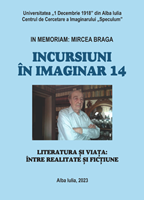RELATED CONCEPTS: CULTURAL MATERIALISM, NEW HISTORICISM, CULTURAL STUDIES
RELATED CONCEPTS: CULTURAL MATERIALISM, NEW HISTORICISM, CULTURAL STUDIES
Author(s): Maria MureșanSubject(s): Culture and social structure , Sociology of Culture, Theory of Literature, Sociology of Literature
Published by: Editura Aeternitas
Keywords: New Historicism; Cultural Materialism; Cultural Studies; metalanguage; metatheory;
Summary/Abstract: Until 1988 Stephen Greenblatt practiced a kind of criticism which was closer to Cultural Materialism in its emphasis on ideology, on the exercise of state power in creating narratives supporting its desired self-image. In “Renaissance Self-Fashioning from More to Shakespeare” (Chicago University Oress, 1982), Greenblatt undertakes a Foucauldian archaeology into the imaginary which caught the public eye in an age reputed for its self-dramatization and acting. Alan Sinfield assumed his position as cultural materialist, which he equates with political dissidence, in his book, “Faultlines” (1992) from the very title: “Faultlines Cultural Materialism and the Politics of Dissident Reading”. Included in this book is an essay on “Cultural Materialism, Othello, and the Politics of Plausibility”. In a New Historicist approach to the play (“The Shakespearean Search for Archetypes”, 2020), Maria-Ana Tupan reads the plot against other texts that circulated at the time, and which account for the cognitive background of the characters. Neema Parvini, a scholar from the University of Surrey, is a telling example of the way New Historicism works, that is, through a historicized and theorized approach to the author in question and through meditation on the tools of his interpretation (metatheory). New Historicism too distances itself from the official canon, focusing on less known texts whose marginalization is seen as the policy of networks of power. Raymond Williams launched a concept somewhat similar to Foucault’s episteme – the “structure of feeling” – and his contribution to cultural anthropology dates back to 1961 when he published “The Long Revolution”. In Marin Sorescu’s “Vărul Shakespeare” (“Cousin Shakespeare”), for instance, Hamlet’s rage against the corruption of the Danish court swells so high because he is absolute for the humanistic ideals and values which were indeed current in the author’s time, but which do not characterize either the time of the action (dated by Saxo Grammaticus at about 1200 AD) nor the time of the author rewriting it for a postmodern audience. Similarly, D. R. Popescu produces a palimpsestic text in his 2012 novel, “Simonetta Berlusconi. Calugarul Filippo Lippi și călugărița Lucrezia Buti”, where not only do characters join a transhistorical party (the author too lapses into the chronodiegetic universe of the Italian Renaissance, visited by a refugee from Vlad the Impaler’s land) but the very ontological stability of the worlds vanishes into the faultlines separating authors, critics, editors, characters. The ongoing discussions about the sources, tenets, concepts and protocols of New Historicism, which are trying to breathe new life into a critical theory which colonized literary studies at the turn of the millennium, are revisionist and summative, locating New Historicism in the general picture assembled by William Wolfreys as editor of a book of essays on “Criticism at the 21st Century ”(Edinburgh University Press, 2002).
Journal: Incursiuni în imaginar
- Issue Year: 1/2023
- Issue No: 14
- Page Range: 273-291
- Page Count: 19
- Language: English

